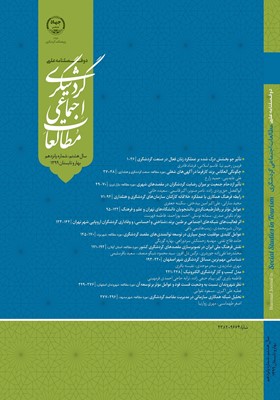عوامل کلیدی موفقیت جمع سپاری در توسعه توانمندیهای مقصد گردشگری (مورد مطالعه: شهر یزد)
محورهای موضوعی :
حامد فلاح تفتی
1
![]() ,
مهدیه زحمتکش سردوراهی
2
,
بهاره گورنگی
3
,
مهدیه زحمتکش سردوراهی
2
,
بهاره گورنگی
3
1 - استادیار، گروه مدیریت، دانشکده علوم انسانی، دانشگاه علم و هنر، یزد، ایران
2 - کارشناسی ارشد مدیریت گردشگری، دانشگاه علم و هنر، یزد، ایران
3 -
کلید واژه: جمع سپاری, مشارکت اجتماعی گردشگران, توسعه توانمندیهای مقصد, تحلیل شبکهای فازی,
چکیده مقاله :
امروزه فناوری اطلاعات، امکان استفاده از نظرات افراد مختلف را با دیدگاههای متنوع فراهم آورده است و یکی از مواهب آن پیدایش روشهای آسان بهرهگیری از نظرات عموم است که جمع سپاری نامیده میشود. ازاینرو هر جا که بهرهگیری از مشارکت اجتماعی منجر به تسهیل در شناسایی و حل مسائل شود جمع سپاری ابزاری کارآمد تلقی میشود. بررسی مطالعات پیشین نشان میدهد تلاش چندانی برای ترغیب مشارکت اجتماعی گردشگران در شناسایی فرصتهای توسعه زیرساختهای عمرانی، فرهنگی و اجتماعی در مقصدهای گردشگری انجام نشده است. شهر یزد یکی از مقصدهای گردشگری تاریخی فرهنگی ایران است که اخیراً در فهرست میراث جهانی یونسکو ثبت گردیده است و توجه گردشگران زیادی را به خود جلب کرده است و ازاینرو نیاز به توسعه توانمندیها و زیرساختهای گردشگری در آن به خوبی احساس میشود. پژوهش حاضر با هدف شناخت معیارهای موفقیت جمع سپاری میان گردشگران در ارائه راهکارهای مناسب در توسعه گردشگری شهر یزد انجام شده است. بدین منظور ابتدا معیارهای ابتدایی در اجرای موفق جمع سپاری با استفاده از ادبیات پژوهش استخراج گردید، سپس با غربالگری آنها با استفاده از روش دلفی، 25 معیار در شش دسته کلی شناسایی شدند. جهت رتبهبندی معیارها نظرات خبرگان حوزه گردشگری شهر یزد در قالب مقایسات زوجی گردآوری و با روش تحلیل شبکهای فازی تحلیل و رتبهبندی شدند. نتایج نشان میدهد معیار اصلی سرمایههای انسانی با وزن 28/0 و شاخصهای فرهنگی با وزن 21/0 بیشترین اهمیت را در موفقیت جمع سپاری میان گردشگران دارا است.
Today, information technology has made it possible to solicit the views of different people with diverse perspectives and ideological backgrounds. Being one of the benefits of IT, crowdsourcing could, as an easy-to-use public opinion survey tool, be used as a very useful instrument wherever social participation may facilitates the identification and resolution of problems. Having carefully reviewed previous studies of the field, we found that few attempts have so far been made to induce tourists to socially participate in identifying the opportunities for the development of civilian, cultural, and social infrastructures of tourist destinations. As one of the Iranian cultural and historical tourist destinations, Yazd city has recently been enlisted in UNESCO World Heritage sites and has attracted the attention of many tourists worldwide. Having said that, it appears that its tourism capacities and infrastructures need to be developed. This study, therefore, sought to identify the criteria which could be effective in the success of tourist crowdsourcing in offering appropriate solutions for the development of tourism in Yazd. To this end, the primary criteria for the successful implementation of crowdsourcing were extracted from the relevant literature, from which 25 criteria in six general categories were screened and identified via Delphi method. To rank the criteria mentioned, the opinions of Yazd tourism experts were collected through paired comparisons, being analyzed and ranked by fuzzy network analysis. The finding of the study indicated that human resources and cultural indices with the weights of 0.28 and 0.21 respectively were the most important factors in the success of tourist crowdsourcing.
